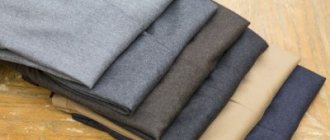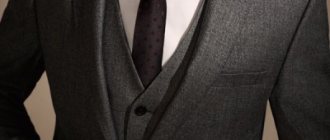Viscose clothing is considered lightweight and practical, but can be damaged by improper cleaning. To prevent this from happening, study in detail our article with tips on how to wash viscose without allowing it to shrink or stretch. And if trouble has already happened, find out how to act correctly in such cases.
This is interesting: mixed fabrics shrink more than 100% viscose.
How to prepare things for washing
Before you begin the cleaning process for viscose clothing, you need to do some preparation to avoid ruining the items. To do this you should:
- Study the labels. They usually indicate the permitted actions during washing, drying and ironing.
- Sort things according to color. Remember that you can only wash items of the same color together: white, colored and black separately.
- Pre-clean. If there is debris, dirt or plant debris stuck to the fabric, pick it out by hand.
- View pockets. All items located there must be removed.
- Turn out. This item will protect the outer side of the fabric from excessive mechanical stress, color fading and possible fading.
- Fasten the zippers and buttons. If these finishing details are present on things, they need to be connected.
- Prepare a laundry bag. If you choose the machine method, this device will definitely come in handy. You can replace it with a regular white pillowcase.
In order to better understand what methods of influencing fabric are allowed, look at the main signs that may appear on the label:
| 100% viscose | This means that the thread is entirely made of cellulose and has no foreign impurities (cotton, linen, etc.) |
| Allows water temperature up to 40 degrees | |
| Prohibits bleaching | |
| Allows ironing at medium temperatures of about 150 degrees. Most often suitable for clothes made from mixed fabrics | |
| Allows normal dry cleaning. Any dry cleaner has a list of acceptable reagents. | |
| Indicates that clothes can be dried vertically |
Production
What is viscose fabric? The definition can be given as follows: natural fiber obtained artificially. How can these two concepts go together? Yes, very simple! You will understand everything when we tell you what viscose fabric is made from.
The basis of the material is cellulose, a substance found in wood. In principle, this is everything that matter is made of. Thus, answering the question what kind of fabric is viscose, whether it is natural or not, we can answer - completely natural. After all, it is obtained from natural material, and not from oil and gas processing products.
Let's look at the main production steps:
- Raw materials (wood) are cleaned, crushed and pre-treated
- Dissolves and removes excess liquid
- The resulting cellulose mass is pressed through filters and fibers are formed
- Fiber processing - drying, pressing, bleaching and then dyeing
So, processed viscose - what kind of fabric does it make?
How to wash viscose by hand: choosing temperature and powder
After you have carefully studied the tag, completed all the preparatory steps and made sure that you are looking at 100% viscose, wash by hand in the following sequence:
- Filling the container with water. Its temperature should not exceed 30 degrees.
- Adding detergent. Please note that it is not advisable to pour the selected substance onto fabrics, so it must first be completely dissolved.
- Soak. It is recommended to soak excessively soiled clothing for 10-30 minutes.
- Wash. Movements should be light and massaging. The fibers do not tolerate strong friction and excessive effort.
- Rinsing. This is repeated many times to prevent the slightest sedimentation of the soapy substance.
- Push-ups. You don't need to do it too hard. It is enough to put things in the sink and lightly press them against the sides. Do not twist, as this may damage the fabric.
- Collapse. If you really need to speed up the drying process, wrap the selected item of clothing in a terry towel, roll it up loosely, blotting off excess water, and repeat the procedure if necessary.
Viscose items respond remarkably well to liquid detergents designed specifically for the care of delicate and thin fabrics. Among them are:
- Perwoll Wolle & Feines Faserpflege Advanced;
- CRYSTAL balm with lanolin;
- Stork EXTRA-soft.
You can also choose products for washing wool, viscose and silk threads. They may contain lanolin, which can provide the necessary care and restore softness to the fabric, and a special polymer will preserve the color of the fabric for a long time.
Tip: if your water is too hard, you can add 1 tbsp during the washing process. ammonia, and when rinsing - the same amount of vinegar. This will soften the water.
In the washing machine: washing mode, temperature, suitable products
In a constantly busy environment, it is sometimes difficult to find time for hand washing, and then machine washing will come to the rescue. These instructions will tell you how to properly and safely wash viscose in a washing machine:
- After carrying out the preparatory manipulations with the clothes, carefully fold the items into a net or bag and close tightly;
- Wash viscose items separately from others. Especially avoid combining with denim or other rough fabric;
- the selected bulk or liquid detergent must be loaded into a special compartment for chemicals. Please read the label carefully before doing this. Perhaps the manufacturer recommends adding their product directly to the drum;
- if your clothes are too dirty, do not forget to add oxygen stain remover or bleach (for white items only);
- pour 0.5-1 cap of conditioner into a specially designed compartment;
- select the appropriate mode: “Delicate fabrics”, “Hand wash”, “Delicate fabrics”;
- the temperature should not exceed 30 degrees;
- turn off the automatic spin and dry mode;
- Once the process is complete, remove the product and place it in the sink or bathtub to let it glass on its own.
Modern automatic machines are very safe for viscose materials, and in combination with professional gels they are perhaps the best choice. In the process you can use the following brands:
- Caress “Magic of Balm”;
- Cashmere;
- Luxus;
- Dalli Woll-Balsam gel;
- Villi.
Reasons for product shrinkage
Clothes may become a couple of sizes smaller if:
- sharp temperature changes were observed during washing and rinsing;
- the product dried near heating devices or in the sun;
- used too hot water;
- During the spin cycle, the machine was set to high speed;
- products with alkali were used;
- the product was steamed with an iron.
Dry cleaning
Some viscose products cannot be wet processed. Therefore, they require dry. It is safe and suitable for cleaning designer dresses, accessories, and of course, viscose carpets. If you have lost the information that was indicated on the tag, do not take risks and clean the items using the following means:
- Spot Remover. Dry substance, quickly and efficiently removes traces of coffee, grease, etc. Convenient for use in travel and public places.
- DRYEL . P&G Cleaning Kit. Good combination of price and quality, has a pleasant aroma. According to consumers, it is easy to use and does an excellent job of cleansing.
- Dry Cleaner Kit from Hagerty. Consists of substances for removing dirt from all types of fabrics and fresheners. It has no hard components. Used in drum dryers and washing machines. Does not affect the fabric, coloring or stretching of fibers, and is safe for weaving threads.
- K2r. Aerosol stain remover for any fabric. Easy to use, acts on the stain from the inside.
- Woolite-gel. Cleans knitted, woolen and knitted clothes. Does not contain aggressive components. Safe for light and colored fabrics.
- Just a minute. Cleaning gel in a tube. Apply to the stain until completely dry. The product is affordable and will even clean the carpet.
Important: dry cleaning is suitable for fabrics that are heavily or partially decorated with rhinestones, sequins, bugles or embroidery.
Types of fabrics with viscose fiber
Let's consider the types of viscose depending on the composition. On the labels you can find the names viscon, viscose, acetate, and the fabric itself can be Turkish, Chinese, European and even Russian, but it is the composition that affects the main characteristics.
100% natural viscose is a very delicate, soft-to-touch clothing material that can be found in stores under the names “Tensel”, “Modal”, “Micromodal”. Without additional additives, viscose fabrics are incredibly tactile and pleasant, but they have one vulnerability - they become fragile when wet.
One of the most popular types of viscose is a favorite staple among fans of the romantic style. This fabric consists exclusively of viscose fibers of the same length, due to which the fabric almost does not wrinkle at all and forms ideal draperies.
Viscose knitwear is a whole group of knitted materials based on viscose fibers. Different in knitting density, percentage of viscose content and decorative characteristics, such fabrics are used for sewing children's and adult clothes and underwear.
Polyviscose is a popular mix of viscose and polyester (acrylic and nylon can also be found). Blended fabric is great for sewing trousers, skirts, jackets. A suit with this name is often found. Taking all the best from natural fabrics - hygiene, softness and the ability to retain colors for a long time after dyeing, polyviscose is also devoid of their disadvantages. Thanks to the polyester in the composition, the fabric wrinkles little and wears well.
Stretch viscose, well suited for women's and sportswear, is always viscose to which lycra, spandex or elastane have been added, since the natural material has virtually no stretch.
You can often find viscose with cotton - a 50/50 duet and other combinations (95 by 5, 70 by 30, 65 by 35 and other percentage variations) allow you to create a fairly durable, dense material, suitable even for sewing trousers and jackets.
Surely, when you read that viscose gives pleasant coolness in the heat, you thought that it would make excellent bedding for the summer. When combined with cotton, viscose is indeed considered a suitable option for lightweight home textiles and bedding. Viscose silk can be used in sewing bed linen and separately, without cotton additives.
Finally, lining viscose is an ideal option for creating a lining when sewing outerwear and warm hats. This is hygienic, because viscose absorbs moisture, unlike many synthetic materials often used for the listed product groups. In addition, thick fabric, especially with the addition of cotton or polyester, glides well, protecting the main fabric from damage.
Our assortment includes different types of viscose materials. The most relevant in the current season and in general in the spring-summer period are, of course, printed staples, dress viscose, various types of knitted and suiting materials with the addition of this fiber. Viscose twill is especially popular in solid colors and with original prints - it is a silky twill weave fabric that is denser than regular viscose.
Which type should you prefer? It all depends on what you plan to sew. A coat, a dress, or maybe you’d prefer nothing at all?
Why is the fabric deformed and how to fix the situation?
Having purchased a beautiful, high-quality item, many housewives think about the question: does viscose shrink when washed or not? We will have to disappoint you, because this material can really become deformed. And the following errors contribute to this:
- Low quality item. If you purchased a product from a dubious manufacturer, is it any wonder that after the first wash it became too small or too big for you.
- Impurities. When the composition indicates the addition of cotton, wool, acrylic, or polyester, then problems may await you during the cleaning process. While these materials add strength to the fabric, they also cause shrinkage and pilling.
- Temperature changes. Make sure that the water temperature does not fluctuate during washing and rinsing.
- Machine drying. Viscose does not tolerate directed air flows from artificial drying using heating and other devices.
- Spin and high speed. Choosing the correct washing mode involves performing it at low drum speeds. But if for some reason you put them higher, get ready for the matter to react to this accordingly - to become stretched.
- Soda, vinegar, ammonia. Using remedies tested by our grandmothers can lead to completely unexpected effects. Therefore, if you prefer them to get rid of stains, be extremely careful when dealing with artificial fabrics.
Next, we will consider in detail how to stretch viscose if it has shrunk after washing, and what to do when it has stretched.
Actions in case of material shrinkage
Many, even the most experienced housewives, wonder what to do if the viscose fabric still shrinks after washing. But it is still possible to return the original appearance of the material. To do this, viscose needs to be stretched immediately after washing. The following tips will help you figure out how to do this:
- You need to take the thing, put it on and walk around until the fabric dries. It is very possible that it will return to its original shape.
- Use a steam generator or an iron with a steam function. Set to a silk-safe setting and gently stretch out the length and sleeves as you go.
- The damaged canvas should be generously moistened, but so that no water flows, and hung on a hanger or placed on a towel. During the drying process, you need to slightly stretch it along, across and along the sleeves. Proceed very carefully.
Be careful: the fabric may not be pulled out evenly, and the item will lose its original appearance.
The viscose has stretched, what should I do?
This happens quite rarely with such material, and therefore few housewives have to look for a solution on how to wash viscose so that it shrinks. But such a way exists.
The process is carried out in hot (up to 60 degrees) water. Proceed with caution and do not subject your clothing to this test for more than 20 minutes. Don't forget to add a sufficient amount of a suitable product, preferably with lanolin. After this procedure, stretched tissues usually return to their original size.
The second option is to use a hair dryer. Give the pre-moistened item the desired size and dry it under a stream of warm air.
In addition to the traditional ones, there are many folk methods:
- Soak the product in hot water for 10-15 minutes and transfer to cold water for 20 minutes. Squeeze lightly and dry in a horizontal position;
- Immerse the item in boiling water for 5 minutes and quickly transfer it to a bowl of cold water (you can sprinkle it with ice cubes). Let sit for 10 minutes, remove and dry flat;
- wash in cold water;
- use a dryer on a heating device. This method is extreme, so only use it as a last resort.
If the clothes are stretched
A stretched product is more difficult to fix. In this case, you need to take into account what fibers are included in the material:
- Viscose and cotton are washed at temperatures above 50 degrees. Afterwards, the clothes are placed in hot water with conditioner for 10 minutes.
- Viscose with synthetic additives is washed at a temperature of 50 degrees, including the spin function. Rinse with cold water.
- Viscose with wool fibers is washed at 60 degrees. Rinse with cold water.
Rapid temperature changes help shorten the length of cellulose fibers.
Drying and ironing viscose items
- Viscose is usually dried on a horizontal surface. Before this, cover the area with a light towel and lay the item down, straightening out all the folds.
- After partial drying, hanging on a hanger with soft hangers is allowed.
- Ironing is carried out at a temperature of about 140 degrees. It corresponds to the mark “Silk” or “Synthetics”.
- The process must be performed from the wrong side, otherwise the surface of the iron may leave obvious shiny marks.
- The steam function is not recommended. Under the influence of hot steam, matter can stretch considerably.
- If necessary, the front side can be ironed through a thin light fabric.
Tip: viscose fabric should be protected from direct sunlight, choosing shaded areas for drying.
As you can see, if you follow all the manufacturers' recommendations and expert advice, caring for viscose will not be difficult. Bright things made from it will serve you for a long time without losing color or shape.
Let's act tougher
If following the simplest tips you cannot save a viscose item, you will have to resort to “improved” methods. Experienced housewives advise not to get upset, but to adopt backup options.
You can try to return the product to its original appearance.
- Prepare a solution of soda (in proportions of 1 tsp per glass of water), moisten a piece of gauze in it. Then you should put a gauze cloth on your clothes and run an iron over it with a steam generator setting.
- Moisten the item in clean water, then treat it with a similar soda solution. Next, you need to roll a viscose blouse or dress into a tube and carefully pull its edges. Then the thing unfolds and twists again, but in the opposite direction. The stretching procedure is repeated. At the end of the manipulations, the product should be rinsed and dried.
- Take a cotton sheet and wet it with a soda solution (one teaspoon of soda per 300 ml of water). The sheet is placed on a horizontal surface and straightened out. The shrunken viscose item should be placed on the canvas and covered with the free edge of the sheet. Wait two hours, then rinse the clothes and dry them.
- Stretch the completely dampened viscose sweater over the back of a chair, box, and dry with a hairdryer.
- Use a weight. This method is suitable when the item has decreased in length. If the hem is shortened, the bottom of the underwear is “grabbed” with an elastic band, where a light weight (400 grams) is then hung. Similar actions can be performed with shrunken sleeves or shorter trousers. In this position, the item can hang for a maximum of an hour, otherwise the bottom will stretch too much and be uneven.
- Moisten the viscose with a vinegar solution (100 ml of vinegar and half a liter of water). The item should be stretched out on a hard surface and secured on four sides with heavy objects. After 30 minutes, you need to rinse the product.
If you don’t want to “tinker” with a shrunken item, it is better to take the item to a trusted dry cleaner. Competent specialists can stretch clothes to the desired size, while maintaining their shape and brightness.











